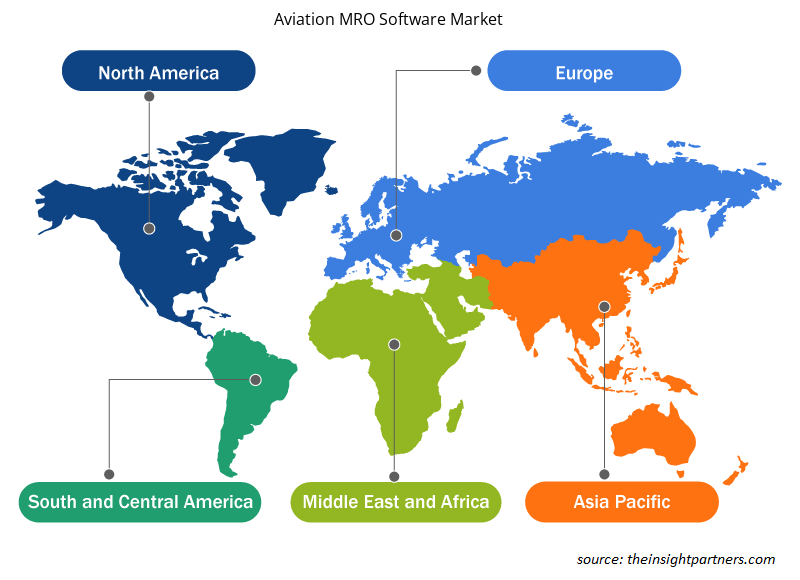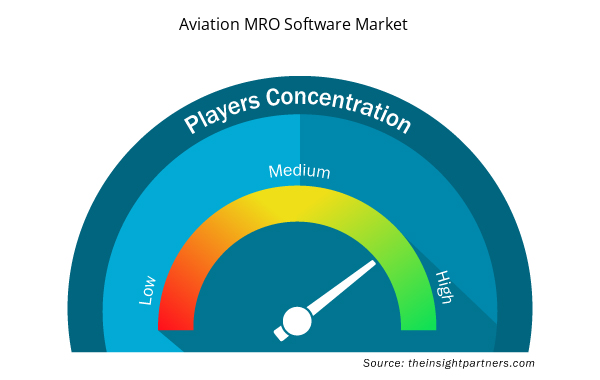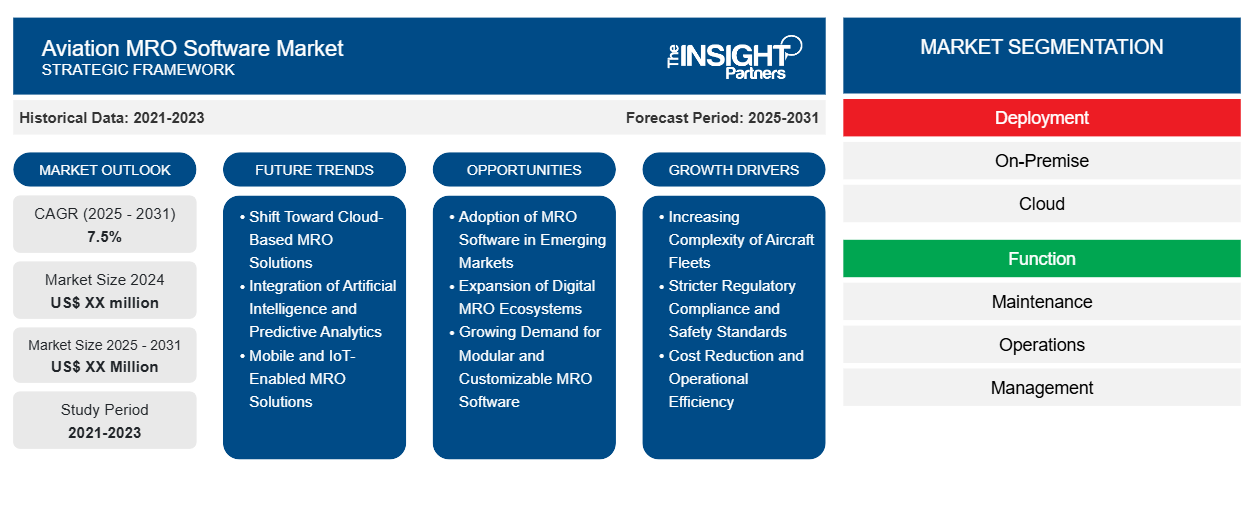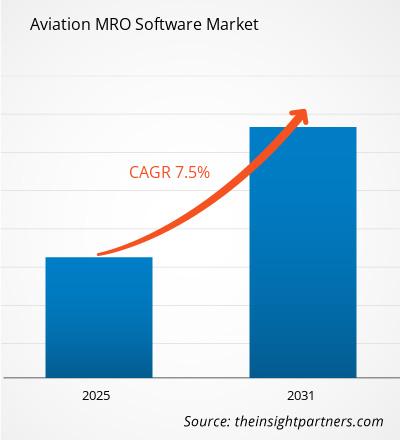Si prevede che il mercato del software MRO per l'aviazione registrerà un CAGR del 7,5% dal 2023 al 2031, con una dimensione di mercato in espansione da XX milioni di dollari nel 2023 a XX milioni di dollari entro il 2031.
Il report è segmentato per Deployment (On-Premise, Cloud), Function [Maintenance (Line, Base, Engine), Operations, Management], Model (Ownership Model, Subscription Model). L'analisi globale è ulteriormente suddivisa a livello regionale e nei principali paesi. Il report offre il valore in USD per l'analisi e i segmenti di cui sopra.
Scopo del rapporto
Il report Aviation MRO Software Market di The Insight Partners mira a descrivere il panorama attuale e la crescita futura, i principali fattori trainanti, le sfide e le opportunità. Ciò fornirà spunti a vari stakeholder aziendali, come:
- Fornitori/produttori di tecnologia: per comprendere le dinamiche di mercato in evoluzione e conoscere le potenziali opportunità di crescita, consentendo loro di prendere decisioni strategiche informate.
- Investitori: condurre un'analisi completa delle tendenze in merito al tasso di crescita del mercato, alle proiezioni finanziarie del mercato e alle opportunità esistenti lungo la catena del valore.
- Enti di regolamentazione: regolamentano le politiche e le attività di controllo sul mercato allo scopo di ridurre al minimo gli abusi, preservare la fiducia degli investitori e sostenere l'integrità e la stabilità del mercato.
Segmentazione del mercato del software MRO per l'aviazione
Distribuzione
- In sede
- Nuvola
Funzione
- Manutenzione
- Operazioni
- Gestione
Modello
- Modello di proprietà
- Modello di abbonamento
Geografia
- America del Nord
- Europa
- Asia-Pacifico
- America del Sud e Centro
- Medio Oriente e Africa
Geografia
- America del Nord
- Europa
- Asia-Pacifico
- America del Sud e Centro
- Medio Oriente e Africa
Personalizza questo report in base alle tue esigenze
Riceverai la personalizzazione gratuita di qualsiasi report, comprese parti di questo report, o analisi a livello nazionale, pacchetto dati Excel, oltre a usufruire di grandi offerte e sconti per start-up e università
- Scopri le principali tendenze di mercato in questo rapporto.Questo campione GRATUITO includerà analisi di dati che spaziano dalle tendenze di mercato alle stime e alle previsioni.
Driver di crescita del mercato del software MRO per l'aviazione
- Aumento della complessità delle flotte di aeromobili: poiché le compagnie aeree e gli operatori aggiornano le loro flotte per includere aeromobili più avanzati e tecnologicamente sofisticati, è cresciuta la necessità di soluzioni software integrate di manutenzione, riparazione e revisione (MRO). Gli aeromobili moderni sono dotati di sistemi più complessi, che richiedono un monitoraggio e una gestione avanzati delle attività di manutenzione. Il software MRO consente una gestione efficiente dei programmi di manutenzione, degli inventari dei pezzi di ricambio e dei registri di conformità, assicurando che questi aeromobili rimangano operativi e rispettino le normative di sicurezza. La crescente complessità delle flotte a livello globale, in particolare nelle regioni con un traffico aereo elevato, sta alimentando la domanda di soluzioni software MRO.
- Conformità normativa e standard di sicurezza più rigorosi: il settore dell'aviazione è altamente regolamentato, con autorità come FAA, EASA e ICAO che applicano rigide linee guida per la sicurezza e la manutenzione degli aeromobili. Queste normative richiedono alle compagnie aeree di mantenere registri completi, eseguire ispezioni regolari e rispettare i protocolli di sicurezza. Il software MRO aiuta le organizzazioni ad automatizzare il monitoraggio della conformità, gestire la documentazione in modo efficiente e generare report necessari per garantire l'aderenza alle normative locali e internazionali. Il continuo rafforzamento delle normative di sicurezza funge da motore principale per l'adozione del software MRO nelle operazioni di aviazione.
- Riduzione dei costi ed efficienza operativa: in un ambiente competitivo delle compagnie aeree, gli operatori sono sotto pressione costante per ridurre i costi di manutenzione migliorando al contempo l'efficienza operativa. Il software MRO consente alle aziende di ottimizzare i propri programmi di manutenzione, ridurre i tempi di fermo non programmati e prolungare la durata di vita dei componenti critici. Automatizzando vari processi, come la gestione degli ordini di lavoro, il monitoraggio dell'inventario e la pianificazione della manodopera, le aziende di aviazione possono tagliare i costi, ridurre gli errori umani e semplificare le proprie operazioni, rendendo il software MRO uno strumento prezioso per ottenere risparmi sui costi e miglioramenti dell'efficienza
Tendenze future del mercato del software MRO per l'aviazione
- Passaggio a soluzioni MRO basate su cloud: le soluzioni software MRO basate su cloud stanno diventando sempre più popolari nel settore dell'aviazione. La tecnologia cloud consente l'accesso in tempo reale ai dati, l'archiviazione centralizzata e la collaborazione senza soluzione di continuità tra team geograficamente dispersi. Le compagnie aeree e i fornitori MRO stanno adottando piattaforme cloud per migliorare la condivisione dei dati tra i reparti, migliorare il processo decisionale e ridurre le spese generali IT. La scalabilità e la flessibilità offerte dalle soluzioni cloud stanno guidando il passaggio dal tradizionale software on-premise ai sistemi MRO basati su cloud, consentendo alle compagnie aeree di gestire le proprie operazioni in modo più efficace ed economico.
- Integrazione di intelligenza artificiale e analisi predittiva: l'integrazione di intelligenza artificiale e analisi predittiva nel software MRO sta trasformando il modo in cui la manutenzione viene gestita nel settore dell'aviazione. Analizzando i dati storici e utilizzando algoritmi di apprendimento automatico, il software MRO basato sull'intelligenza artificiale può prevedere potenziali guasti delle apparecchiature e ottimizzare i programmi di manutenzione. La manutenzione predittiva aiuta a identificare i problemi prima che si verifichino, riducendo i tempi di fermo non programmati e le costose riparazioni. Questa tendenza verso soluzioni software MRO potenziate dall'intelligenza artificiale sta semplificando per le compagnie aeree la gestione delle proprie flotte con maggiore precisione e la prevenzione di costose interruzioni operative.
- Soluzioni MRO abilitate per dispositivi mobili e IoT: il crescente utilizzo di dispositivi mobili e dell'Internet of Things (IoT) nelle operazioni di aviazione sta influenzando lo sviluppo del software MRO. Le soluzioni MRO abilitate per dispositivi mobili consentono ai team di manutenzione di accedere a dati, registri e ordini di lavoro in tempo reale dal campo, migliorando i tempi di risposta e l'efficienza della manutenzione. L'integrazione IoT consente ai dispositivi sugli aeromobili di comunicare direttamente con il software MRO, fornendo dati continui sulle prestazioni dei componenti. Questa tendenza sta migliorando la capacità di eseguire la manutenzione predittiva, migliorare il monitoraggio delle risorse e fornire informazioni in tempo reale sulle operazioni di manutenzione, guidando l'adozione di queste soluzioni MRO avanzate
Opportunità di mercato per il software MRO per l'aviazione
- Adozione del software MRO nei mercati emergenti: i mercati emergenti, in particolare in Asia-Pacifico, Medio Oriente e Africa, presentano significative opportunità di crescita per il mercato del software MRO per l'aviazione. Queste regioni stanno vivendo una rapida crescita nei viaggi aerei, con conseguente aumento della domanda di servizi di manutenzione e sofisticati strumenti software. Man mano che le compagnie aeree e gli operatori in queste regioni modernizzano le loro flotte e aumentano la loro scala operativa, aumenterà la necessità di soluzioni software MRO efficienti. Questa tendenza apre opportunità per i fornitori di software MRO di espandere la loro presenza e offrire soluzioni su misura per soddisfare le esigenze uniche di questi mercati in crescita.
- Espansione degli ecosistemi MRO digitali: lo sviluppo di ecosistemi MRO digitali, in cui le piattaforme software si integrano con vari stakeholder quali compagnie aeree, fornitori di manutenzione, OEM (Original Equipment Manufacturers) e fornitori, offre ai fornitori di software l'opportunità di creare soluzioni complete end-to-end. Questi ecosistemi consentono uno scambio di dati senza interruzioni, una migliore collaborazione e il monitoraggio in tempo reale di parti e servizi lungo la supply chain. Integrando le loro piattaforme con altri stakeholder del settore, i fornitori di software possono migliorare la proposta di valore delle loro soluzioni MRO e attingere alla crescente domanda di operazioni di manutenzione interconnesse e semplificate.
- Domanda crescente di software MRO modulare e personalizzabile: poiché le compagnie aeree e i fornitori di manutenzione cercano di ottimizzare le loro operazioni, c'è una domanda crescente di soluzioni software MRO modulari e personalizzabili che possono essere adattate per soddisfare esigenze specifiche. Le compagnie aeree con composizioni di flotta diverse richiedono software in grado di gestire diversi tipi di aeromobili, programmi di manutenzione e requisiti di conformità. I fornitori che offrono soluzioni flessibili e modulari, in cui singoli moduli per la gestione dell'inventario, la programmazione della manutenzione e il monitoraggio della conformità possono essere aggiunti o personalizzati, saranno molto richiesti. Questa flessibilità consente alle aziende di adottare software MRO che si adatti ai loro requisiti operativi unici, aprendo opportunità per gli sviluppatori di software di innovare e diversificare le loro offerte.
Approfondimenti regionali sul mercato del software MRO per l'aviazione
Le tendenze regionali e i fattori che influenzano il mercato del software MRO per l'aviazione durante il periodo di previsione sono stati ampiamente spiegati dagli analisti di Insight Partners. Questa sezione discute anche i segmenti e la geografia del mercato del software MRO per l'aviazione in Nord America, Europa, Asia Pacifico, Medio Oriente e Africa e America centrale e meridionale.

- Ottieni i dati specifici regionali per il mercato del software MRO per l'aviazione
Ambito del rapporto di mercato del software MRO per l'aviazione
| Attributo del report | Dettagli |
|---|---|
| Dimensioni del mercato nel 2023 | XX milioni di dollari USA |
| Dimensioni del mercato entro il 2031 | XX milioni di dollari USA |
| CAGR globale (2023-2031) | 7,5% |
| Dati storici | 2021-2022 |
| Periodo di previsione | 2024-2031 |
| Segmenti coperti | Per distribuzione
|
| Regioni e Paesi coperti | America del Nord
|
| Leader di mercato e profili aziendali chiave |
|
Densità dei player del mercato del software MRO per l'aviazione: comprendere il suo impatto sulle dinamiche aziendali
Il mercato del software MRO per l'aviazione sta crescendo rapidamente, spinto dalla crescente domanda degli utenti finali dovuta a fattori quali l'evoluzione delle preferenze dei consumatori, i progressi tecnologici e una maggiore consapevolezza dei vantaggi del prodotto. Con l'aumento della domanda, le aziende stanno ampliando le loro offerte, innovando per soddisfare le esigenze dei consumatori e capitalizzando sulle tendenze emergenti, il che alimenta ulteriormente la crescita del mercato.
La densità degli operatori di mercato si riferisce alla distribuzione di aziende o società che operano in un particolare mercato o settore. Indica quanti concorrenti (operatori di mercato) sono presenti in un dato spazio di mercato in relazione alle sue dimensioni o al valore di mercato totale.
Le principali aziende che operano nel mercato del software MRO per l'aviazione sono:
- La compagnia Boeing
- IBM
- Azienda
- SAP SE
- Tecnologie HCL
Disclaimer : le aziende elencate sopra non sono classificate secondo un ordine particolare.

- Ottieni una panoramica dei principali attori del mercato del software MRO per l'aviazione
Punti chiave di vendita
- Copertura completa: il rapporto copre in modo completo l'analisi di prodotti, servizi, tipologie e utenti finali del mercato del software MRO per l'aviazione, fornendo una panoramica olistica.
- Analisi degli esperti: il rapporto è compilato sulla base della conoscenza approfondita di esperti e analisti del settore.
- Informazioni aggiornate: il rapporto garantisce la pertinenza aziendale grazie alla copertura di informazioni recenti e tendenze nei dati.
- Opzioni di personalizzazione: questo report può essere personalizzato per soddisfare le esigenze specifiche del cliente e adattarsi in modo appropriato alle strategie aziendali.
Il rapporto di ricerca sul mercato del software MRO per l'aviazione può quindi aiutare a guidare il percorso di decodifica e comprensione dello scenario del settore e delle prospettive di crescita. Sebbene possano esserci alcune preoccupazioni valide, i vantaggi complessivi di questo rapporto tendono a superare gli svantaggi.
- Analisi storica (2 anni), anno base, previsione (7 anni) con CAGR
- Analisi PEST e SWOT
- Valore/volume delle dimensioni del mercato - Globale, regionale, nazionale
- Industria e panorama competitivo
- Set di dati Excel



Report Coverage
Revenue forecast, Company Analysis, Industry landscape, Growth factors, and Trends

Segment Covered
This text is related
to segments covered.

Regional Scope
North America, Europe, Asia Pacific, Middle East & Africa, South & Central America

Country Scope
This text is related
to country scope.
Domande frequenti
Some of the customization options available based on request are additional 3-5 company profiles and country-specific analysis of 3-5 countries of your choice. Customizations are to be requested/discussed before making final order confirmation, as our team would review the same and check the feasibility.
The report can be delivered in PDF/PPT format; we can also share excel dataset based on the request.
The major factors driving the aviation MRO software market are:
1. Increasing Air Travel.
2. Rising Presence of MRO Service Providers in Emerging Economies
Some of the major trends driving the aviation MRO software market are:
1. Growing Integration of Digital Technology in MRO Industry
2. Retrofitting of Older Aircraft Fleet
The Aviation MRO Software Market is estimated to witness a CAGR of 7.5% from 2023 to 2031
Trends and growth analysis reports related to Aerospace and Defense : READ MORE..
1. The Boeing Company
2. IBM
3. Ramco Systems Ltd.
4. SAP SE
5. HCL Technologies
6. ORACLE
7. Swiss Aviation Software AG
8. IBS Software
9. COMMSOFT
10. Flatirons Solutions
The Insight Partners performs research in 4 major stages: Data Collection & Secondary Research, Primary Research, Data Analysis and Data Triangulation & Final Review.
- Data Collection and Secondary Research:
As a market research and consulting firm operating from a decade, we have published and advised several client across the globe. First step for any study will start with an assessment of currently available data and insights from existing reports. Further, historical and current market information is collected from Investor Presentations, Annual Reports, SEC Filings, etc., and other information related to company’s performance and market positioning are gathered from Paid Databases (Factiva, Hoovers, and Reuters) and various other publications available in public domain.
Several associations trade associates, technical forums, institutes, societies and organization are accessed to gain technical as well as market related insights through their publications such as research papers, blogs and press releases related to the studies are referred to get cues about the market. Further, white papers, journals, magazines, and other news articles published in last 3 years are scrutinized and analyzed to understand the current market trends.
- Primary Research:
The primarily interview analysis comprise of data obtained from industry participants interview and answers to survey questions gathered by in-house primary team.
For primary research, interviews are conducted with industry experts/CEOs/Marketing Managers/VPs/Subject Matter Experts from both demand and supply side to get a 360-degree view of the market. The primary team conducts several interviews based on the complexity of the markets to understand the various market trends and dynamics which makes research more credible and precise.
A typical research interview fulfils the following functions:
- Provides first-hand information on the market size, market trends, growth trends, competitive landscape, and outlook
- Validates and strengthens in-house secondary research findings
- Develops the analysis team’s expertise and market understanding
Primary research involves email interactions and telephone interviews for each market, category, segment, and sub-segment across geographies. The participants who typically take part in such a process include, but are not limited to:
- Industry participants: VPs, business development managers, market intelligence managers and national sales managers
- Outside experts: Valuation experts, research analysts and key opinion leaders specializing in the electronics and semiconductor industry.
Below is the breakup of our primary respondents by company, designation, and region:

Once we receive the confirmation from primary research sources or primary respondents, we finalize the base year market estimation and forecast the data as per the macroeconomic and microeconomic factors assessed during data collection.
- Data Analysis:
Once data is validated through both secondary as well as primary respondents, we finalize the market estimations by hypothesis formulation and factor analysis at regional and country level.
- Macro-Economic Factor Analysis:
We analyse macroeconomic indicators such the gross domestic product (GDP), increase in the demand for goods and services across industries, technological advancement, regional economic growth, governmental policies, the influence of COVID-19, PEST analysis, and other aspects. This analysis aids in setting benchmarks for various nations/regions and approximating market splits. Additionally, the general trend of the aforementioned components aid in determining the market's development possibilities.
- Country Level Data:
Various factors that are especially aligned to the country are taken into account to determine the market size for a certain area and country, including the presence of vendors, such as headquarters and offices, the country's GDP, demand patterns, and industry growth. To comprehend the market dynamics for the nation, a number of growth variables, inhibitors, application areas, and current market trends are researched. The aforementioned elements aid in determining the country's overall market's growth potential.
- Company Profile:
The “Table of Contents” is formulated by listing and analyzing more than 25 - 30 companies operating in the market ecosystem across geographies. However, we profile only 10 companies as a standard practice in our syndicate reports. These 10 companies comprise leading, emerging, and regional players. Nonetheless, our analysis is not restricted to the 10 listed companies, we also analyze other companies present in the market to develop a holistic view and understand the prevailing trends. The “Company Profiles” section in the report covers key facts, business description, products & services, financial information, SWOT analysis, and key developments. The financial information presented is extracted from the annual reports and official documents of the publicly listed companies. Upon collecting the information for the sections of respective companies, we verify them via various primary sources and then compile the data in respective company profiles. The company level information helps us in deriving the base number as well as in forecasting the market size.
- Developing Base Number:
Aggregation of sales statistics (2020-2022) and macro-economic factor, and other secondary and primary research insights are utilized to arrive at base number and related market shares for 2022. The data gaps are identified in this step and relevant market data is analyzed, collected from paid primary interviews or databases. On finalizing the base year market size, forecasts are developed on the basis of macro-economic, industry and market growth factors and company level analysis.
- Data Triangulation and Final Review:
The market findings and base year market size calculations are validated from supply as well as demand side. Demand side validations are based on macro-economic factor analysis and benchmarks for respective regions and countries. In case of supply side validations, revenues of major companies are estimated (in case not available) based on industry benchmark, approximate number of employees, product portfolio, and primary interviews revenues are gathered. Further revenue from target product/service segment is assessed to avoid overshooting of market statistics. In case of heavy deviations between supply and demand side values, all thes steps are repeated to achieve synchronization.
We follow an iterative model, wherein we share our research findings with Subject Matter Experts (SME’s) and Key Opinion Leaders (KOLs) until consensus view of the market is not formulated – this model negates any drastic deviation in the opinions of experts. Only validated and universally acceptable research findings are quoted in our reports.
We have important check points that we use to validate our research findings – which we call – data triangulation, where we validate the information, we generate from secondary sources with primary interviews and then we re-validate with our internal data bases and Subject matter experts. This comprehensive model enables us to deliver high quality, reliable data in shortest possible time.


 Ottieni un campione gratuito per questo repot
Ottieni un campione gratuito per questo repot